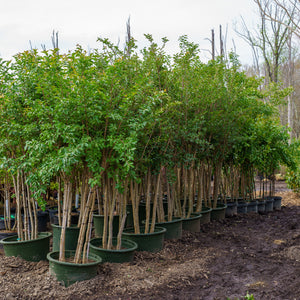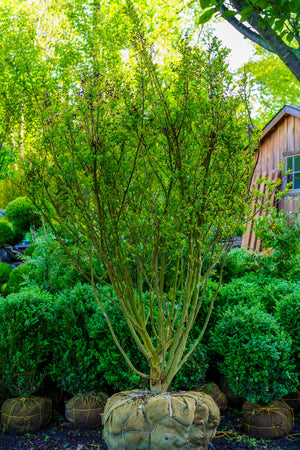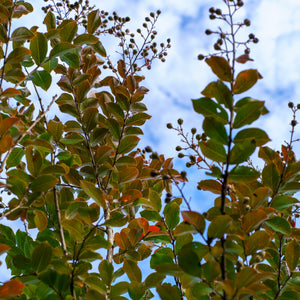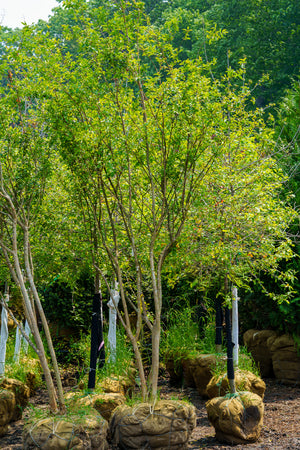Muskogee Crape Myrtle: A Flourish of Summer Blooms and Elegance
Welcome to this week’s edition of our "Plant of the Week" series! This week, we are happy to introduce you to the Muskogee Crape Myrtle (Lagerstroemia indica x fauriei 'Muskogee'). Known for its striking lavender flowers and smooth, mottled bark, the Muskogee Crape Myrtle is a favorite among gardeners and landscapers alike. Whether you're looking to add a splash of color to your garden or seeking a low-maintenance, resilient tree that thrives in hot, sunny climates, the Muskogee Crape Myrtle has much to offer. Join us as we explore the unique features, uses, and care tips for this exceptional tree, and learn why it deserves a spot in your garden.
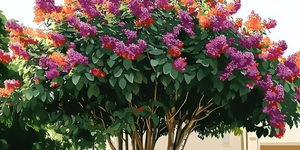
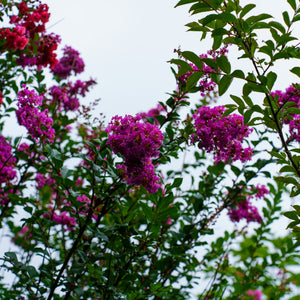
What Makes Muskogee Crape Myrtle Special?
The Muskogee Crape Myrtle stands out in any landscape, thanks to its long-lasting summer blooms and impressive resilience. This tree is a hybrid between Lagerstroemia indica and Lagerstroemia fauriei, combining the best traits of both species.
One of the most notable features of the Muskogee Crape Myrtle is its abundant clusters of soft lavender flowers, which bloom profusely from early summer to fall. The blooms are so prolific that they almost entirely cover the tree, creating a breathtaking display of color. The flowers are arranged in large, showy panicles that can reach up to 12 inches in length, making the Muskogee a standout in any garden.
Beyond its vibrant blooms, the Muskogee Crape Myrtle is also prized for its attractive, smooth bark, which exfoliates to reveal a stunning mosaic of light brown, gray, and tan hues. This feature adds year-round interest to the landscape, particularly during the winter months when the tree is bare of leaves.
In addition to its beauty, the Muskogee Crape Myrtle is incredibly resilient. It is highly drought-tolerant once established, thrives in full sun, and is resistant to common diseases like powdery mildew. Its tolerance to heat and humidity makes it an excellent choice for southern gardens, although it can also thrive in other regions.
The tree’s upright, multi-stemmed form and moderate growth rate make it versatile in the landscape. It can be trained as a small tree or allowed to grow as a large shrub, depending on your preference. The Muskogee Crape Myrtle reaches a mature height of 15-25 feet and a spread of 10-15 feet, making it suitable for both small and large gardens.
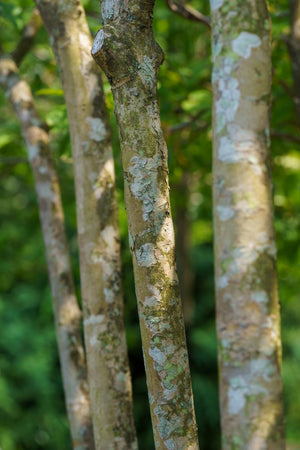
What Is Muskogee Crape Myrtle Used For?
The Muskogee Crape Myrtle is a highly versatile plant that can be used in a variety of landscape settings. Here are some of the key ways you can incorporate this stunning tree into your garden:
Ornamental Value: The Muskogee Crape Myrtle is primarily grown for its spectacular floral display. Its long-lasting, lavender blooms add a splash of color to the garden throughout the summer and into the fall, making it an excellent focal point in the landscape. Its attractive bark also provides winter interest, ensuring that the tree remains a visually appealing element year-round.
Shade Provider: Though the Muskogee Crape Myrtle has an open canopy, it can still provide some light shade beneath its branches. This makes it a great choice for creating dappled shade in garden beds or seating areas, where you can enjoy the beauty of the tree while escaping the direct heat of the sun.
Privacy Screening: When planted in groups or as a hedge, the Muskogee Crape Myrtle can be used as a privacy screen or windbreak. Its dense foliage and moderate height make it an effective barrier that also adds beauty to the landscape.
Specimen Plant: The Muskogee Crape Myrtle’s stunning flowers, attractive bark, and graceful form make it an excellent choice as a specimen plant. Whether planted in the center of a lawn, at the entrance of a driveway, or in a prominent garden bed, it will draw attention and admiration.
Container Planting: For those with limited garden space, the Muskogee Crape Myrtle can also be grown in large containers. Its relatively compact size and tolerance to pruning make it suitable for container gardening, allowing you to enjoy its beauty on a patio, deck, or balcony.
Wildlife Habitat: The Muskogee Crape Myrtle’s flowers are a magnet for pollinators, including bees, butterflies, and hummingbirds. By attracting these beneficial creatures, the tree contributes to the overall health and biodiversity of the garden.
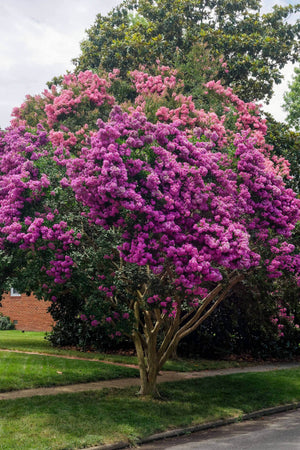
How To Care For Muskogee Crape Myrtle
Caring for the Muskogee Crape Myrtle is relatively straightforward, making it an excellent choice for both novice and experienced gardeners. Here are some tips to ensure your tree remains healthy and beautiful:
Planting: Choose a location with full sun exposure, as the Muskogee Crape Myrtle thrives in bright, direct sunlight. Well-drained soil is essential to prevent root rot, so amend the planting site with organic matter if your soil is heavy or clayey. The best time to plant is in the spring or fall when temperatures are moderate, allowing the tree to establish its root system before the heat of summer or the chill of winter.
Watering: While the Muskogee Crape Myrtle is drought-tolerant once established, it requires regular watering during its first year of growth. Water deeply once a week, allowing the soil to dry out slightly between waterings. During dry spells or periods of extreme heat, increase the frequency of watering to ensure the tree remains hydrated.
Pruning: Pruning is essential to maintaining the shape and health of your Muskogee Crape Myrtle. Prune in late winter or early spring before new growth begins. Remove any dead or damaged branches, and thin out crowded areas to improve air circulation. To encourage more blooms, you can also prune back the previous season's growth by about one-third.
Fertilizing: Fertilize your Muskogee Crape Myrtle in early spring with a balanced, slow-release fertilizer. This will provide the necessary nutrients for healthy growth and abundant blooms. Avoid over-fertilizing, as this can lead to excessive foliage growth at the expense of flowers.
Mulching: Apply a layer of organic mulch around the base of the tree to help retain moisture, regulate soil temperature, and suppress weeds. Keep the mulch a few inches away from the trunk to prevent moisture buildup and potential rot.
Protection: Although the Muskogee Crape Myrtle is hardy, young trees may benefit from protection during their first winter. Consider using a burlap wrap or tree guard to shield the trunk from harsh winds and freezing temperatures.
CONCLUSION
The Muskogee Crape Myrtle (Lagerstroemia indica x fauriei 'Muskogee') is a stunning and resilient tree that brings year-round interest to any garden. With its vibrant lavender blooms, attractive bark, and graceful form, it’s no wonder that this tree is a favorite among gardeners. Whether you’re looking to add a focal point to your landscape, create a privacy screen, or simply enjoy the beauty of its long-lasting flowers, the Muskogee Crape Myrtle is an excellent choice. By following the care tips outlined above, you can ensure that your tree remains healthy and continues to delight for years to come. Whether in urban settings, rural landscapes, or cozy backyard gardens, the Muskogee Crape Myrtle will undoubtedly bring beauty, color, and elegance to any space it graces.

